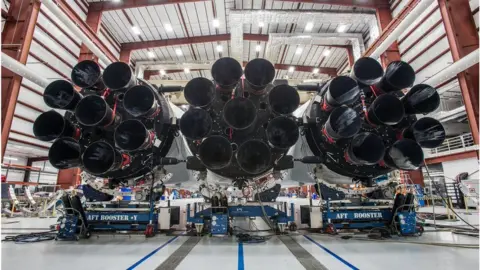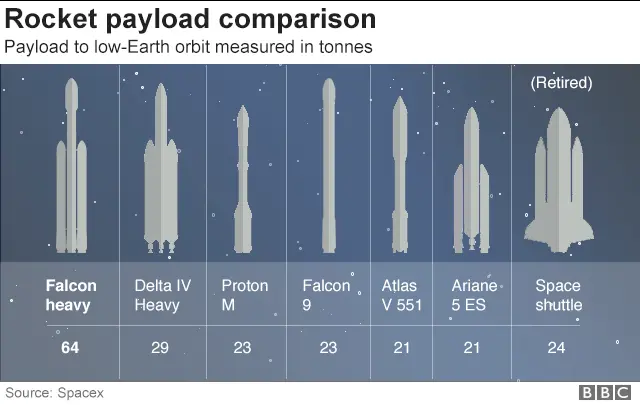Falcon Heavy: Big SpaceX rocket lights 27 engines
 SPACEX
SPACEXAmerica's SpaceX company has conducted a key test ahead of the maiden flight of its new rocket - the Falcon Heavy.
In what is known as a static firing, all 27 engines on the launcher's first stage were ignited together to check they are flight-ready.
The procedure, conducted in Florida, lasted only seconds and the rocket was clamped to keep it on the ground.
The Falcon Heavy will be the most powerful launcher in the world when it eventually lifts off.
Depending on the analysis of Wednesday's test, that could occur within the next fortnight.
Company CEO and chief designer, Elon Musk, tweeted: "Falcon Heavy hold-down firing this morning was good. Generated quite a thunderhead of steam. Launching in a week or so."
Allow X content?

 SPACEX
SPACEXThe Falcon Heavy is essentially three of SpaceX's workhorse Falcon 9 vehicles strapped together.
But the triple-booster configuration has demanded a number of specific alterations, including a strengthening of the central core booster.
The 27 Merlin engines at the base of the rocket should be capable of generating almost 23,000 kilonewtons of thrust - slightly more than double that of the world's current most powerful rocket, the Delta IV Heavy, which is operated by US competitor United Launch Alliance.
 SPACEX
SPACEXThe 70m-tall Falcon Heavy is designed to put up to a maximum of 64 tonnes in low-Earth orbit, although in reality it will be rare that the vehicle lofts this much mass.
SpaceX intends to land the rocket's boosters back on Earth after launch - as is the company's usual practice today with the Falcon 9 - and that necessarily negates some performance.
But the new capability would mean the firm in future has no difficulty launching the biggest military and commercial telecommunications satellites - and is still able to recover all three first-stage boosters.
The introduction of the rocket should also open up some fascinating possibilities to send much bigger payloads beyond Earth orbit than is currently possible. This could include sending astronaut capsules to the Moon, or bigger robots to Mars.
Because the maiden flight of any rocket carries a higher degree of risk, the Falcon Heavy will not take up a meaningful payload when it finally launches.
Instead, Mr Musk has decided to put his old sportscar on the top of the Falcon Heavy. His idea is to send this red roadster towards the orbit Mars takes around the Sun.

 SPACEX
SPACEX[email protected] and follow me on Twitter: @BBCAmos
